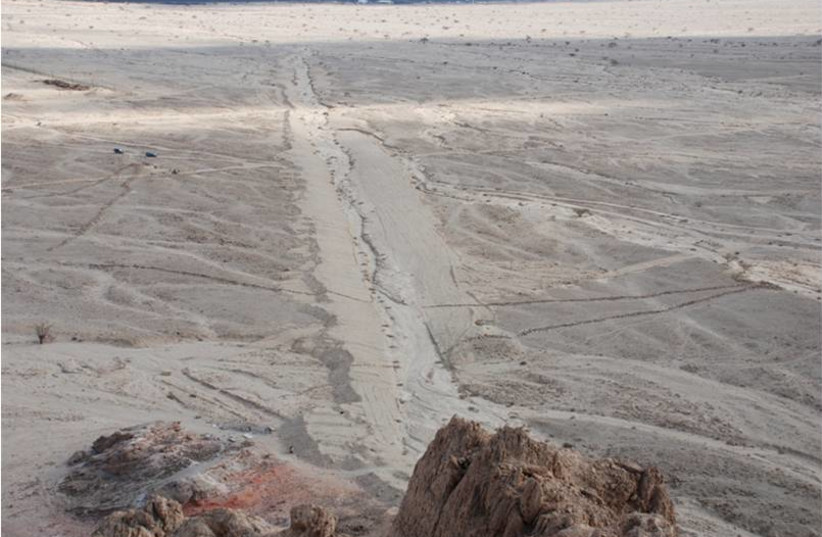Archaeologists find architecture plans for mystery desert structures – study
Archaeologists managed to find what may be the first ever manmade plans for large-scale mega-structure construction in Jordan and Saudi Arabia, a new study has found.
The findings of this study were published in the peer-reviewed online academic journal PLOS ONE.
Known as desert kites, the purpose of these structures was not to fly like the name would imply, but rather were very large and sophisticated traps to enclose animals for hunting.
However, the discovery of these plans – which are very precise in their measurements, especially for something as big as a desert kite – may also shed light on just how much humanity was able to be aware of spatial discernment even in ancient times.
What are desert kites? The first large-scale human architectural achievements
Also known as desert traps, the desert kites were very large structures with dry stone walls as much as five kilometers in length though maybe just a meter high in a kite shape.
Scientists believe the walls, known as driving lines, would be used to “guide” wild prey animals like gazelles into the structure, where they could be trapped for hunters inside four-meter-deep pits.
 A desert kite is seen in the Negev in southern Israel (Illustrative). (credit: Wikimedia Commons)
A desert kite is seen in the Negev in southern Israel (Illustrative). (credit: Wikimedia Commons)This hunting technique, in and of itself, isn’t anything too unique or advanced. What is more impressive and interesting is the fact that these kites exist at all, especially with how old they are – some kites date back to over 11,000 years ago.
With walls as long as they are, it is unsurprising to say that desert kites were enormous. Though widespread throughout the Middle East – and similar structures also existing in Europe, Japan, South Africa and the Americas – they were only ever properly rediscovered in the 1920s by images taken from planes.
In other words, the sheer size and scope of a desert kite can only be fully grasped from the sky, and not from the ground.
As a result, scientists were always fascinated by how such massive architectural structures were made, as this would have needed very sophisticated social structure and communication.
That’s where this study comes in.
The researchers behind this study, the result of an international collaborative effort, examined engravings from southeastern Jordan and northern Saudi Arabia, the oldest of which dated back to as much as 8,000 years ago.
These engravings not only depicted desert kites but seemed to have matched the kites that were located nearby.
The Jordanian engraving was found in the Jibal al-Khasabiyeh plateau, which is home to eight different desert kites. Here, the engravings were found to be around 7,000 years old. The engraving was made on a 92-kilogram limestone monolith with a well-preserved depiction of the kite, with the two main converging driving lines depicted as being around 40 centimeters in length with a star-shaped enclosure section nearly 26 centimeters wide.
The Saudi Arabian engraving was found in Zebel az-Zilliyat, which has two visible desert kites located around 3.5 kilometers apart from each other.
This engraving is different from the Jordanian one, as while the engraving in Jibal a-Khasabiyeh was made with known tools and techniques, researchers have no clue what tools were used here.
This engraving displays two kites on a 382-centimeter long, 235-centimeter wide sandstone boulder. This one shows one kite with driving lines roughly 80 and 85 centimeters long to a star-shaped enclosure with a diameter between 50-60 centimeters. The second kite appears somewhat similar but has been heavily damaged by erosion.
What is so significant is that the engravings are to scale, with a ratio of around 1:175. The sheer similarities and precision in these engravings lead the researchers to conclude that they must have been made by either those who would use the kites or their builders.
The fact that they are to scale is important here.
Humanity has been drawing and engraving for thousands of years, including depictions of maps and pictures of other structures. However, these all were mental representations and were never to scale. As such, they can be seen as more artistic and abstract depictions.
The fact that these engravings are to scale, though, seems to indicate that these were full-fledged architectural plans – blueprints for desert kites.
This can be further supported by other depictions of desert kites that aren’t to scale, examples of which have been found in Jordan, Syria and Uzbekistan. They all lack the level of detail or depiction of the inner pits as 3D objects rather than just circles. It was also impossible to definitively identify these other desert kite depictions with a specific kite, unlike these new ones.
But all of this raises a question: Why plan out desert kites to such an extent?
The researchers propose three possible explanations.
First, it is possible that it was a literal layout plan for its construction. This is seen as less likely because it doesn’t include enough topographical information, though it is still possible.
Second, it may have been used to help formulate strategies for collective hunting efforts. This is more likely, but it could also have been done with a simpler diagram not necessarily to scale.
Thirdly, it may have been for symbolic purposes as a means of passing down knowledge. This is likely true to some extent, but does not rule out the other two possibilities either.
What is certainly true, though, is that the fact that these engravings exist shows that humanity had mastered a means of ascertaining measurements and transcribing them down. This itself is a milestone in the evolution of humanity’s intelligent behavior and advancement.





Comments are closed.